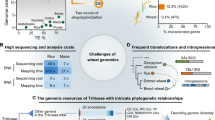Summary
-
1.
Pachytene chromosome structure of the 3 Brassica species B. campestris (genome a; n=10), B. oleracea (genome c; n=9), and B. nigra (genome b; n=8) is described. In each of these species the same 6 chromosome types can be recognized by such structural characteristics as total length, symmetry of arms, and especially shape of the heterochromatic centromere region.
-
2.
B. campestris is doubly tetrasomic for 2 chromosomes of different type and hexasomic for another chromosome type. B. oleracea is a triple tetrasomic, B. nigra a double tretasomic. The chromosome types present in increased numbers are different ones in the 3 species. The formulas for the genomes are: a = AA B C DD E FFF, c = A BB CC D EE F, and b = A B C DD E FF.
-
3.
Secondary paring has been observed in pachytene of a triploid aac-hybrid, proving partial homology in the different genomes of some chromosomes belonging to the same structural type.
-
4.
In each of the 3 genomes the duplicated chromosomes can be recognized by the occurrence of secondary pairing, the frequency of which depends on the degree of structural similarity. Secondary pairing is found in pachytene as well as metaphase I and II.
-
5.
These results agree with earlier observations (see Discussion) and confirm the presence of balanced secondary polyploidy in Brassica derivable from a basic chromosome number x=6.
Similar content being viewed by others
Literatur
Alam, Z.: Cytological studies of some Indian oleiferous Cruciferae. III. Ann. Bot. 50, 85–102 (1936).
Allgayer, H.: Genetische Untersuchungen mit Gartenkohl (Brassica oleracea) nach Kreuzungsversuchen von Richard Freudenberg. Z. indukt. Abstamm.u. Vererb.-Lehre 47, 191–260 (1928).
Bajer, A.: Change of length and volume of mitotic chromosomes in living cells. Hereditas (Lund) 45, 579–596 (1959).
Catcheside, D. G.: The chromosomal relationships in the swede and turnip groups of Brassica. Ann. Bot. 48, 601–633 (1934).
- Secondary pairing in Brassica oleracea. Cytologia (Tokyo) Fujii Jub. Bd., S. 366–378 (1937).
Darlington, C. D.: The behaviour of polyploids. Nature (Lond.) 119, 390–392 (1927).
Eberle, P.: Cytologische Untersuchungen an Gesneriaceen. I. Mitt. Die Struktur der Paehytänchromosomen, sowie eine Reihe neu bestimmter Chromosomenzahlen. Chromosoma (Berl.) 8, 285–316 (1956).
—: Cytologische Untersuchun-gen an Gesneriaceen. II. Mitt. Die Verkürzung eu- und heterochromatischer Chromosomenabschnitte vom Pachytän bis zur Metaphase I. Ber. dtsch. bot. Ges. 70, 323–332 (1957).
Focke, W. O.: Die Pflanzenmischlinge. Berlin 1881.
Gottschalk, W.: Die Grundzahl der Gattung Solanum und einiger Nicotiana Arten. Ber. dtsch. bot. Ges. 67, 369–376 (1954a).
—: Die Chromosomenstruktur der Solanaceen unter Berücksichtigung phylogenetischer Fragestellungen. Chromosoma (Berl.) 6, 539–626 (1954b).
—: Die Paarung homologer Bivalente und der Ablauf von Partnerwechseln in den frühen Stadien der Meiosis autopolyploider Pflanzen. Z. indukt. Abstamm.-u. Vererb.-Lehre 87, 1–24 (1955).
—: Untersuchungen über die Variabilität der Struktur von Pachytänchromosomen. Ber. dtsch. bot. Ges. 71, 381–398 (1958).
Gröber, K.: Multivalentbildung und „secondary association“ in den Stadien der Meiosis autotetraploider Rassen der Gattung Lycopersicon Mill. Kulturpflanze. 6, 198–236 (1958).
Haga, T.: Relationship of genom to secondary pairing in Brassica. (A preliminary note). Jap. J. Genet. 8, 277–284 (1938a).
—: On genoms in the genus Brassica. (A collective review.) Jap. J. Genet. 14, 74–90 (1938b).
Heilborn, O.: The mechanism of the socalled secondary association between chromosomes. Hereditas (Lund) 22, 167–188 (1936).
Kwan, C. C.: Inheritance of some plant characters in cabbage, Brassica oleracea var. capitata. J. Agr. Ass. China No 126-127, S. 81–127 (1934).
Lawrence, W. J. C.: The genetics and cytology of Dahlia species. J. Genet. 21, 125–159 (1929).
—: The secondary association of chromosomes. Cytologia (Tokyo) 2, 352–384 (1931).
Lima De Faria, A.: Chromomere analysis of the chromosome complement of rye. Chromosoma (Berl.) 5, 1–68 (1952).
Linnert, G., Untersuchungen über die Cytologie polyploider Pflanzen II. Chromosoma (Berl.) 3, 399–417 (1949).
—: Die Struktur der Pachytänchromosomen in Euchromatin und Heterochromatin und ihre Auswirkung auf die Chiasmabildung bei Salvia-Arten. Chromosoma (Berl.) 7, 90–128 (1955).
Malinowski, E.: Genetics of Brassica. Bibliogr. Genet. 5, 1–26 (1929).
Mizushima, U.: Karyogenetical studies on Brassiceae. [Japanisch.] Tokyo: Gihodo, 1952.
Morinaga, T.: Interspecific hybridization in Brassica. I. The cytology of F1hybrids of B. napella and various other species with 10 chromosomes. Cytologia (Tokyo). 1, 16–27 (1929).
—: Interspecific hybridization in Brassica. VI. The cytology of F1-hybrids of B. juncea and B. nigra. Cytologia (Tokyo) 6, 62–67 (1934).
Oehlkers, F. u., P. Eberle: Spiralen und Chromomeren in der Meiosis von Bellevalia romana. Chromosoma (Berl.) 8, 351–363 (1957).
Olsson, G., and A. Hagberg: Investigations on haploid rape. Hereditas (Lund) 41, 227–237 (1955).
Pease, M. S.: Genetic studies in Brassica oleracea. J. Genet. 16, 363–385 (1926).
Ramanujam, S.: A haploid plant in toria (Brassica campestris L.). Proc. Indian Acad. Sci. 14, 25–34 (1941).
—, and D., Srinivasachar: Cytogenetic investigations in the genus Brassica and the artificial synthesis of B. juncea. Indian J. Genet. Plant Breeding 3, 73–88 (1943).
Richharia, R. H.: Cytological investigation of Raphanus sativus, Brassica oleracea, and their F1 and F2 hybrids. J. Genet. 34, 19–44 (1937a).
—: Cytological investigation of 10-chromosome species of Brassica and their F2-hybrids. J. Genet. 34, 45–55 (1937b).
Rieger, R.: Inhomologenpaarung und der Meioseablauf bei haploiden Formen von Antirrhinum majus L. Chromosoma (Berl.) 9, 1–38 (1957).
Shibata, K.: Cytogenetical studies of F1-plants of Brassica pekinensis (4x) × B. napus. Kromosomo (Tokyo) 31, 1029–1035 (1956).
Sikka, K.: Cytogenetics of Brassica hybrids and species. J. Genet. 40, 441–509 (1940).
Thompson, K. F.: Production of haploid plants of marrow-stem kale. Nature (Lond.) 178, 748 (1956).
U, N.: Genome analysis in Brassica with special reference to the experimental formation of B. napus and peculiar mode of fertilization. Jap. J. Bot. 7, 389–452 (1935).
Yarnell, S. H.: Cytogenetics of the vegetable crops. II. Crucifers. Bot. Rev. 22, 81–166 (1956).
Author information
Authors and Affiliations
Additional information
Für unermüdliche Hilfe bei den mikroskopischen Untersuchungen danke ich meiner Frau, Dr. Ch. Röbbelen, für finanzielle Unterstützung dieser Arbeit der Deutschen Forschungsgemeinschaft.
Rights and permissions
About this article
Cite this article
Röbbelen, G. Beiträge zur Analyse des Brassica-Genoms. Chromosoma 11, 205–228 (1960). https://doi.org/10.1007/BF00328652
Received:
Issue Date:
DOI: https://doi.org/10.1007/BF00328652




